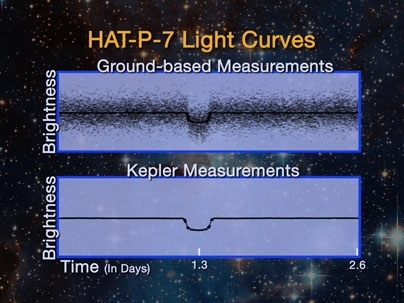The first results are in from the Kepler orbiting observatory, the world's most powerful planet-searching telescope, and according to MIT planetary scientist Sara Seager they show that the instrument should have no trouble detecting "alien Earths" — planets that are about the size of our own.
After its launch on March 6, Kepler began taking test data for engineering purposes. It was this engineering data, before the official inauguration of science operations, that produced the observatory's first published results, appearing this week in the journal Science. Seager, the Ellen Swallow Richards Associate Professor of Planetary Science and Associate Professor of Physics, is part of the Kepler science team but was not personally involved in this initial paper. She appeared at a NASA press conference on Thursday, Aug. 6, to comment on the significance of the results.
"These are very exciting times for exoplanets," Seager said, because for the first time astronomers are getting enough data to be able to answer basic questions about the composition of planets orbiting other stars, and how they compare to the familiar planets of our own solar system.
The new data prove that Kepler's capabilities are as great as the astronomers had expected and that the telescope is now fully operational. Kepler was designed to be the first telescope capable of discovering many Earth-sized planets around other stars, and the new data "show that Kepler can indeed do this," she said.
The Kepler telescope is designed for nonstop monitoring of a field of view containing 100,000 stars, staring at them continuously to observe the slight dip in brightness that occurs whenever a planet passes in front of a star.
A video animation of the smooth rise and fall of the light output between transits caused by the changing phases of a planet.
The details from the new observations provided "a truly spectacular measurement of what we call the 'thermal phase curve' of a hot Jupiter," Seager said. "Hot Jupiters" are planets comparable in size to the giant planet Jupiter, but located so close to their parent stars that they are strongly heated by the star's radiation.
In the case of this previously observed planet, called HAT-P-7, the new data show the planet is "tidally locked" so that it always has the same side facing towards the star (just as our own moon always shows the same side toward Earth). As a result, that side is extremely hot, while the opposite side remains much cooler. The thermal phase curve is a graph that plots the varying brightness from the planet as it revolves around the star once every 2.2 days, getting brighter when the hot side faces us and dimmer when the cool side faces us.
"I am personally very excited about this result because it comes from only 10 days of Kepler data," Seager said, adding that over Kepler's expected operating lifetime of 3.5 years, there will be so much more data that it should become possible to learn many additional details about the nature of this planet, as well as many others.
After its launch on March 6, Kepler began taking test data for engineering purposes. It was this engineering data, before the official inauguration of science operations, that produced the observatory's first published results, appearing this week in the journal Science. Seager, the Ellen Swallow Richards Associate Professor of Planetary Science and Associate Professor of Physics, is part of the Kepler science team but was not personally involved in this initial paper. She appeared at a NASA press conference on Thursday, Aug. 6, to comment on the significance of the results.
"These are very exciting times for exoplanets," Seager said, because for the first time astronomers are getting enough data to be able to answer basic questions about the composition of planets orbiting other stars, and how they compare to the familiar planets of our own solar system.
The new data prove that Kepler's capabilities are as great as the astronomers had expected and that the telescope is now fully operational. Kepler was designed to be the first telescope capable of discovering many Earth-sized planets around other stars, and the new data "show that Kepler can indeed do this," she said.
The Kepler telescope is designed for nonstop monitoring of a field of view containing 100,000 stars, staring at them continuously to observe the slight dip in brightness that occurs whenever a planet passes in front of a star.
A video animation of the smooth rise and fall of the light output between transits caused by the changing phases of a planet.
The details from the new observations provided "a truly spectacular measurement of what we call the 'thermal phase curve' of a hot Jupiter," Seager said. "Hot Jupiters" are planets comparable in size to the giant planet Jupiter, but located so close to their parent stars that they are strongly heated by the star's radiation.
In the case of this previously observed planet, called HAT-P-7, the new data show the planet is "tidally locked" so that it always has the same side facing towards the star (just as our own moon always shows the same side toward Earth). As a result, that side is extremely hot, while the opposite side remains much cooler. The thermal phase curve is a graph that plots the varying brightness from the planet as it revolves around the star once every 2.2 days, getting brighter when the hot side faces us and dimmer when the cool side faces us.
"I am personally very excited about this result because it comes from only 10 days of Kepler data," Seager said, adding that over Kepler's expected operating lifetime of 3.5 years, there will be so much more data that it should become possible to learn many additional details about the nature of this planet, as well as many others.







